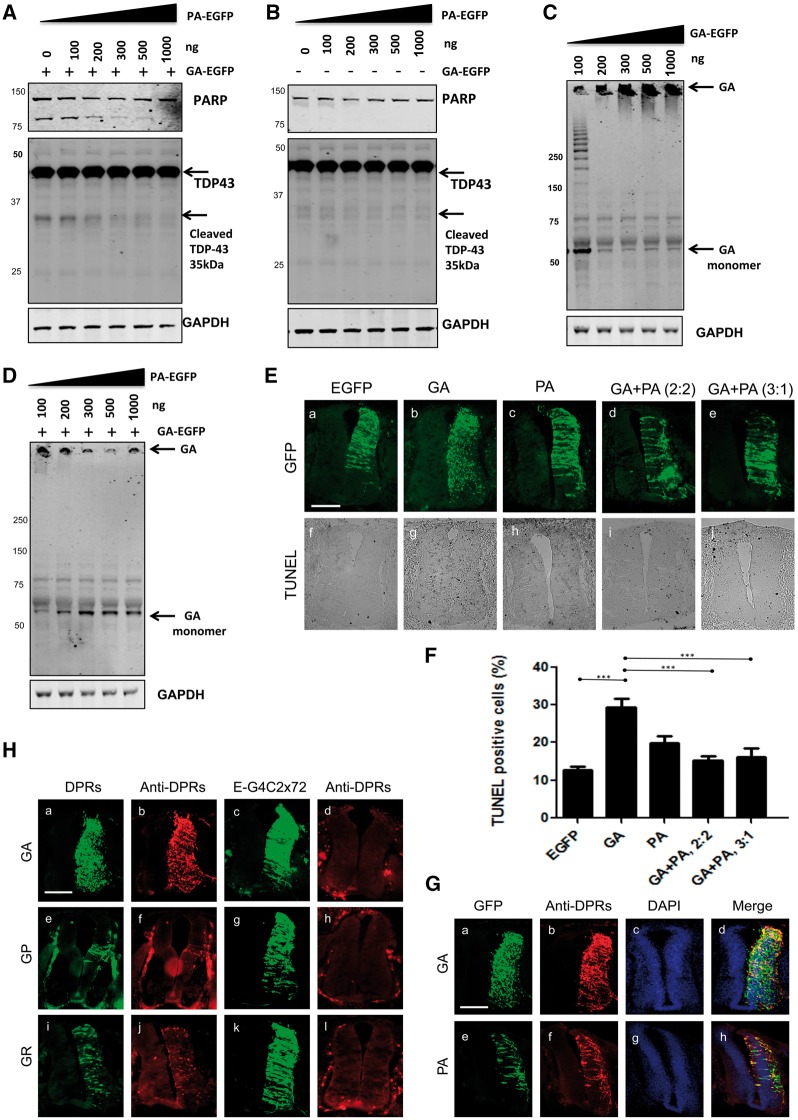Figure 7.
Poly PA inhibits poly GA toxicity in chick spinal cord: DPR versus RNA toxicity of G4C2 hexanucleotide repeats. (A) Cleaved PARP and TDP-43 were assessed in lysates, of HEK-293 cells co-transfected with GA (250 ng) and increasing concentrations of PA-EGFP (0-1000 ng). (B) PA-EGFP expression did not increase PARP cleavage. Increasing concentrations of PA-EGFP (0-1000 ng) were transfected without GA-EGFP. (C) High molecular weight GA-EGFP species is increased in a dose-response manner. Total cell lysates from GA-EGFP (50–1000 ng) transfected HEK-293 cells were used for anti-GA western blotting. (D) PA-EGFP inhibits GA-EGFP aggregation. The appearance of high molecular weight GA-EGFP species is inhibited by a gradual increase of PA-EGFP. (E) PA-EGFP rescues GA-EGFP- mediated toxicity in the chick spinal cord. Transverse sections of embryonic day 3.5 (E3.5) chick embryo spinal cords (dorsal at top), electroporated with DPR constructs as labelled – GA and PA embryos were electroporated with 2 µg of plasmid. GA-EGFP: PA-EGFP (2: 2) and GA-EGFP: PA-EGFP (3: 1) were electroporated with different concentrations (µg) of plasmids as indicated. Scale bar = 100 μm. (F) Quantitative analysis of TUNEL-positive cells showing that the number of TUNEL- positive GA-EGFP expressing cells are significantly decreased by PA-EGFP expression in chick spinal cord (***P<0.0001). (G) GA-EGFP and PA-EGFP expression in chick spinal cord were detected by immunostaining for GA and PA. Scale bar = 100 μm. DAPI and GFP show subcellular localization of DPRs by using DPR antibodies. Scale bar= 100 μm. (H) Comparison of DPR expression between synthetic DPR construct and G4C2 repeat construct by DPR immunostaining in chick spinal cord. The GA-EGFP, GP-EGFP, and GR-EGFP constructs (a, e, i) are transfected with the same amount of EGFP-G4C2x 72 repeat construct (c, g, k). DPR expression levels were compared with specific poly GA, poly GP and poly GR antibodies. Scale bar = 100 μm. The data were analysed from six embryos in three independent sets of experiments.

